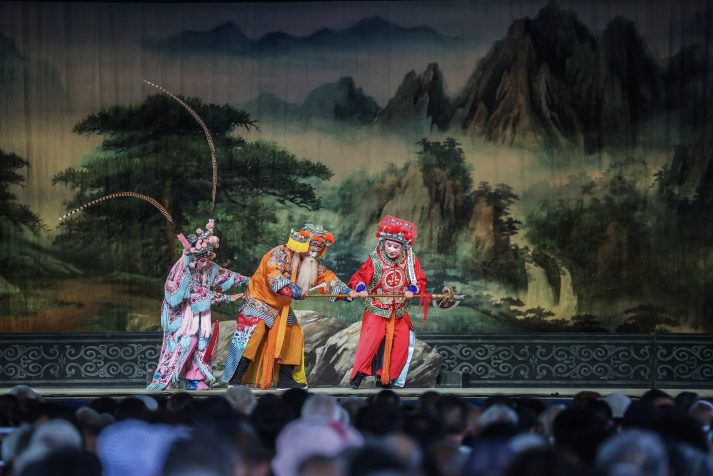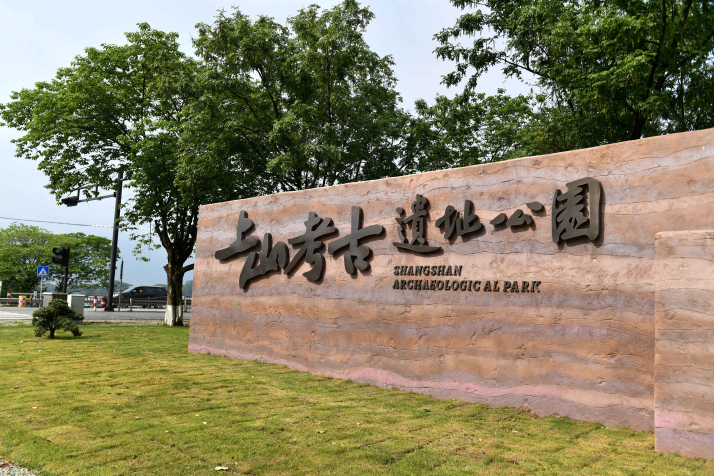| China |
| Zhejiang turns itself into a force of imagination | |
|
|
 A Wuju Opera performance in Wuyi County, Zhejiang, on June 17 (XINHUA)
Born in Wuyi County, Zhejiang Province, in December 1983, Yang Xiayun's journey with Wuju Opera, a traditional opera genre native to the region and known for its six different vocal styles, began at the age of 14, when she joined the Zhejiang Wuju Opera Troupe. Over the years, she has witnessed the remarkable transformation of this 600-year-old theater form, known for its blend of martial arts, acrobatics and traditional storytelling. Yang's breakthrough role as the White Bone Demon in Three Strikes on the White Bone Demon has made her nothing short of an online phenomenon. The production, adapted from the 16th-century Chinese novel Journey to the West, reimagines the classic tale with cutting-edge theatrics—such as her rapid "triple face and costume transformations"—captivating audiences in over 20 countries since its debut in 2023. Wuju was designated a national intangible cultural heritage in 2008 and has since received more funds essential for inheritance and modernization initiatives. Yang herself therefore was given the opportunity to be mentored by master actress Chen Meilan, who championed intergenerational collaboration. Today, Yang pays it forward, training new performers and advocating for rural cultural development. "As a traditional opera genre, Wuju faces challenges in expanding its audience base. It must create high-quality productions that resonate with contemporary audiences," Yang told newspaper People's Daily. Three Strikes on the White Bone Demon's popularity mirrors Zhejiang's broader cultural boom, driven by the province's strategic eight major cultural development projects launched two decades ago. These initiatives encompass efforts to produce fine cultural works, advance academic research and preserve cultural heritage, and other goals and have propelled Wuju from regional stages to international acclaim.  The Shangshan Archaeological Park in Pujiang County, Zhejiang Province, on May 12 (XINHUA)
A cultural powerhouse The Eighth Plenary Session of the 11th Communist Party of China (CPC) Zhejiang Provincial Committee, which was held in July 2005, adopted a decision to accelerate the province's cultural development. It outlined eight major projects, initiated by then Secretary of the CPC Zhejiang Provincial Committee Xi Jinping. These projects span eight major areas: cultural-ethical standards, cultural excellence, cultural research, cultural preservation, cultural industry promotion, cultural infrastructure development, cultural communication and talent cultivation. These initiatives have continuously injected momentum into Zhejiang's cultural prosperity. The two decades that followed saw substantial progress. Today, Zhejiang boasts an extensive and well-structured cultural heritage preservation network, including three UNESCO World Heritage sites, five national archaeological parks, 281 nationally protected cultural relics units, 10 state-level historical and cultural cities and 926 rural museums. This system ensures the effective conservation and inheritance of local cultural legacy. The province has established a five-tier public cultural service framework spanning from provincial to village levels. It currently comprises 102 cultural centers, 102 public libraries, 1,367 township or subdistrict-level comprehensive cultural stations, and 18,600 rural cultural halls, providing accessible resources for all residents. Moreover, over the past 20 years, the province's annual added value of cultural and related industries has surged from 44.2 billion yuan ($6 billion) to 615 billion yuan ($86 billion), while their share of regional GDP has risen from 3 percent to more than 7 percent, solidifying their status as a major driver of economic growth. Innovative approach As a trailblazer in China's cultural innovation, Zhejiang has promoted the convergence of culture and technology, opening up new paths for cultural development. For example, the Wuju show Three Strikes on the White Bone Demon integrates drone technology into its stage effects. In the original Journey to the West tale, hero Sun Wukong, also known as the Monkey King, creates magical duplicates of himself to battle a myriad of demons. Traditionally, theaters used wire-pulled puppets or offstage actors to simulate these "clones," but the effects often appeared stiff—and unconvincing. In collaboration with tech firms in Hangzhou, capital of Zhejiang, the Zhejiang Wuju Opera Troupe developed custom mini-drones to portray the Monkey King's magical transformations. This conveys the iconic character's supernatural abilities more vividly than traditional stagecraft ever could. At the Zhejiang Intangible Cultural Heritage Museum, an augmented reality (AR) guide system developed by Hangzhou-based technology company Rokid is revolutionizing the methods of presenting traditional culture. Through an immersive experience, visitors can transcend time and feel the pulse of history. As visitors, wearing AR glasses, make their way through the exhibition hall, they will see blue markers appear above key exhibits. Approaching these markers activates videos and voice narrations about the artifacts and illustrations, with around 20 AR guide markers throughout the museum. The combination of audio and visuals allows visitors to gain a deeper understanding of the heritage on display. The museum is also planning to launch a digital avatar that will, via the AR glasses, accompany and guide visitors, enhancing their experience of the rich heritage on display. Public services To ensure more people can access and enjoy a broader cultural life, Zhejiang has been promoting the 15-Minute Quality Cultural Life Circle, which means that urban and rural residents can access high-quality public cultural services within a 15-minute walk (approximately a 1.5-km radius). To be specific, within just a quarter of an hour, residents can reach at least one essential public cultural facility, such as cultural centers and libraries, and at least two non-profit cultural spaces, like cultural stations and rural museums. Zhu Miaoyin, a community worker in Fushan Subdistrict, Yuecheng District, Shaoxing, said her residential community's cultural life circle boasts prestigious institutions including the Shaoxing Museum and Xu Wei Art Gallery, alongside over 30 primary-level cultural service centers. "This summer, many children in our community have been flocking to the community reading room to study and do homework—some are so engrossed that their parents can't even get them to come home for meals," Zhu told Xinhua News Agency. "From seniors to children, everyone can enjoy cultural services right at their doorstep." Jimingshan in Yiwu is an international residential community that is home to some 30,000 residents from nearly 60 countries and regions. It has established a cultural center with an all-ages, cross-cultural reading hub, addressing the diverse needs of domestic and international residents. The community's collection now exceeds 6,000 volumes, including more than 1,000 across eight languages including English, Korean and Arabic. The center also hosts 120 annual reading events with a 65-percent resident participation rate. "I enjoy the cultural vibe at the center, where people from different countries find a sense of belonging while also learning about Chinese culture," Egyptian businessman Elsayed Aboutaleb, who lives in Jimingshan and has taken part in various cultural activities hosted by the center, told Beijing Review. (Print Edition Title: Creative Currents) Copyedited by Elsbeth van Paridon Comments to luyan@cicgamericas.com |
|
||||||||||||||||||||||||||||||
|